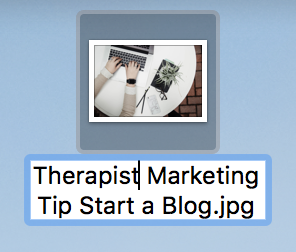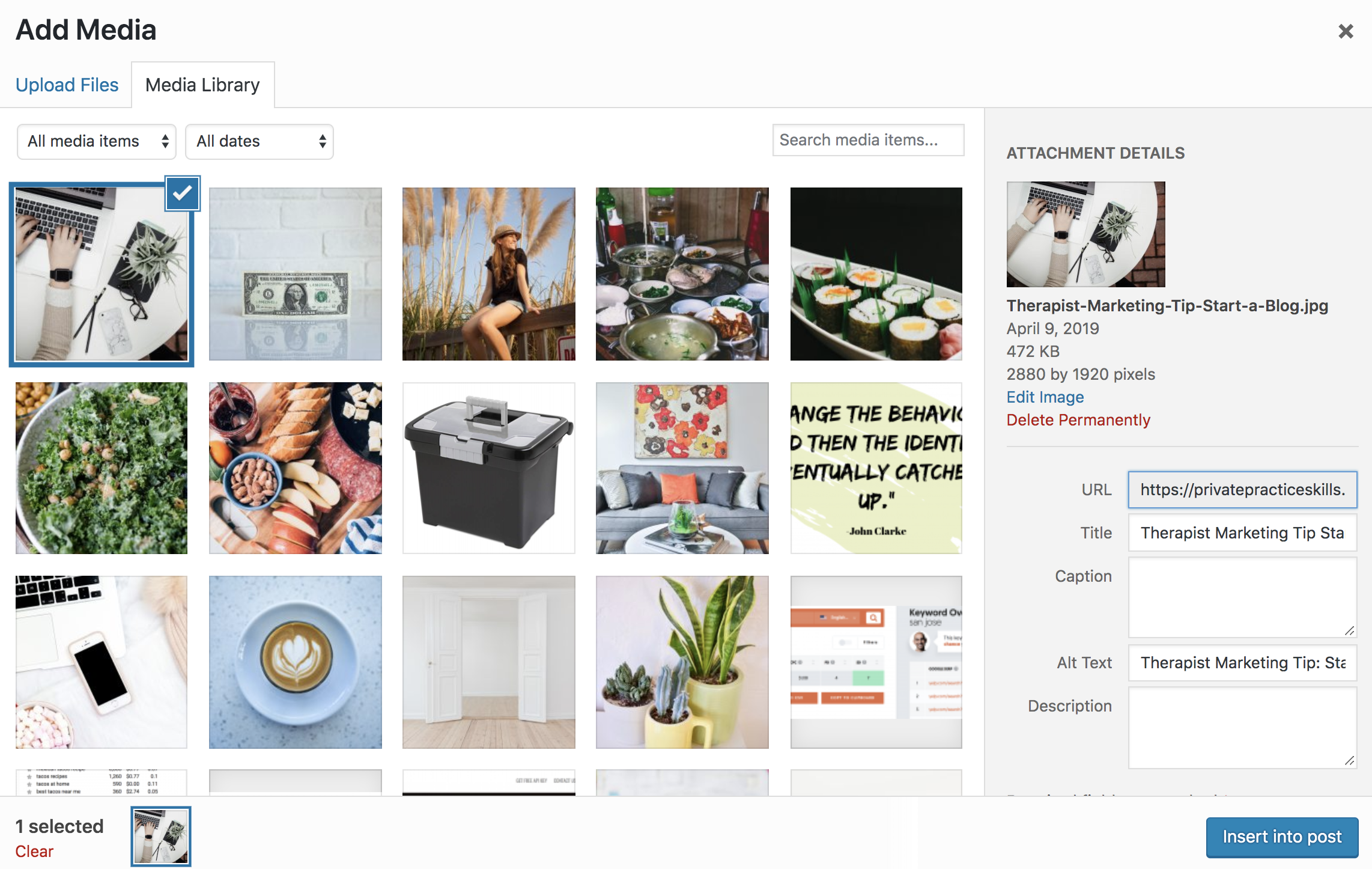So you see other therapists out there with their fancy looking blogs and you likely think, That looks like a lot of work! And what good does it even do anyway?
Let me tell you: starting a blog is completely worth it in private practice, but it doesn’t have to take up all of your time. In this article, I share how you can efficiently start a blog to market your private practice effectively.

When I first started in private practice, I was an intern in a group practice with 15 therapists. We each needed to write a blog post once per year – just once a year!
Inevitably, whenever it was my turn to write my blog post, I would sit and stare at a blank computer screen for hours. I thought I needed to come up with the most impossibly profound thing to say in one epic blog post.
Often, I never even got it done (or started).
Can you relate?
Start a Blog as a Therapy Marketing Strategy
Blogging does’t have to be so tricky. Over a few years I figured out a system where I only spend an hour – at most – writing a blog post (this one included!). That one hour even includes the process of sharing on social media and drafting an email to send to my email list subscribers. I show you here how to do it.
There are so many reasons why it’s worth starting a blog! Here are just a few of my favorites:
1. Help potential clients find you.
Every time you post a blog, Google sees that as a new web page affiliated with your site. The more web pages affiliated with your site, the more opportunities potential clients have to find your website in a Google search.
2. Boost your SEO.
If you’ve read my article about SEO for Therapists then you know how important SEO is in order to show up in search engines. Blogging boosts your SEO in two major ways:
- Every time you post a blog, your keyword research makes it easier for potential clients to find that post in a Google search.
- The more web pages you have tied to your primary therapist business domain, the higher that website will show in search results. Posting consistently helps show Google that you are an active user and builds a sense of authority for your website.
3. Build trust.
This applies both to potential clients and referral resources. Imagine if you were looking for a therapist for yourself and you had a few different therapists’ websites pulled up, wouldn’t you gravitate towards the one who has great content on their blog?
Not only can you show who you are through the voice you bring to your blog, but so few therapists blog actively that simply by showing up in this format you help yourself stand out from the crowd.
I’ve also found that by blogging regularly, potential referral resources connect with my content and are more likely to offer my name when they know someone who is looking for a therapist.
Whenever I meet with a new client, I like to ask why they decided to choose me amongst the plethora of therapists in my area. More often than not, clients tell me that they were looking at a few different therapists’ websites, but a particular blog post I wrote spoke to exactly what they needed support with.
4. Offer resources for current and past clients.
In private practice, clients tend to come for a while and then take a break until they eventually disappear into the shadows. Blogging is a great way for clients you’ve met with before to stay connected with you. This makes an easier on-ramp for them to return to therapy in the future.
How to Start a Blog for Counseling Private Practice
Alright, so you might be thinking: All of that sounds great Marie, but there’s just no way I can write blog posts regularly!
You totally can do it! Here are my tips to get you started with your first blog post:
1. Connect your blog to your therapy business page.
Most web service providers like Wix, WordPress, Squarespace, and others have a blog platform built in. Make sure you use this built-in blog feature rather than creating a separate domain name.
The benefit of this is that connecting the blog with your primary domain name helps boost that domain’s SEO.
Every time you write a blog post and add it to a page on your website, Google takes the keywords from your post into account when potential clients search for a therapist. Think of it like this: each blog post drops a few pennies into your SEO piggy bank. One post might not make a huge difference, but if you keep saving those pennies they will really start to add up your SEO game over time.
2. Write what you know.
This is where I messed up in my pre-licensed blogging days. I thought I needed to sound like I knew everything about all things mental health.
The reality is, we’re all an expert in something. So rather than try to focus on being like so-and-so who’s really awesome at whatever, just be yourself. When you are yourself and you bring that into your blog post, it has two major advantages:
- It saves you time in writing the post because you’re writing about something you can easily talk about, and
- It helps potential clients see who you are because you’re writing from a similar perspective that you speak from in-session (this is brand consistency in a nutshell, but we’ll save that topic for another day!)
3. Solve a problem.
I see so many therapists make the mistake of focusing solely on their expertise, training, or experience when writing a blog.
This is not what potential clients want to see.
Potential clients want to know that you see them and the exact problem that they’re dealing with. They want to hear some tools for how you can help them with their specific issue.
Blog posts are a perfect platform to tackle a single problem your ideal clients might be experiencing. By offering simple tips to help potential clients resolve that problem, you start to build a sense of trust with them before they ever contact you.
The idea is NOT to squeeze an entire therapy session in your blog post. It’s just to be able to send somebody away with a helpful tool to solve that problem.
4. Keyword research.
Keyword research is a critical step in having a stellar blog post that potential clients find in Google searches. Be sure to check out my article all about using Keyword Research to boost your SEO.
The tips from this article apply to each individual blog post. I encourage you to start out dividing your time about 50/50 – spend half your time on keyword planning and the other half of your time writing the actual blog post. Yep, it’s that important!
5. Keep it simple.
Sometimes we try to cram every life lesson imaginable into a single blog post. Not only does this make way too much work out of each post, but it ends up being way more content than your reader likely bargained for.
Blogs that are shorter and to the point will help you hone in your focus for each post and will also be much easier for potential clients to read and follow along.
If you do get stuck cramming 500 things into one post, see if you can divide that post into two or even five different posts. Then pat yourself on the back for coming up with your next several blog post topics!
6. Use copyright-free photos.
I like to use Unsplash to discover beautiful photos and credit the creator when possible. When you save the photo to your computer, change the title of the photo to your keywords or blog post title like this:

Once you upload the photo into your website editor, also include those same keywords in the alt tags. Most website builders have an option for you to update the alt tag. This is super helpful for boosting that post’s SEO. Here’s a photo of what it looks like for me in WordPress:

You can see where it says “title” and “alt tags” I used the same keywords I’m utilizing for this post.
7. Include keywords
Be sure to also use these same keywords in your URL, title, meta-description, headers, and tags, as well as organically throughout the post. This will help people find your post when they do a Google search.
Make sure those keywords are an authentic reflection of what information exists in your post. If your keywords are misleading, people will click away from your blog post almost as soon as they arrive.
Google keeps track of this data and will cause your site to rank lower if people are clicking away from your page within a few seconds of arriving.
8. Consistency is key!
If you find all of these tips completely overwhelming, it’s better to just go ahead and write a blog post anyway, see what comes out, make mistakes, learn from the mistakes, and keep going.
I rather you start a blog and do it imperfectly then wait until you have the perfect blog together and potentially never do it.
I hope you found this therapist marketing tip helpful as you start a blog for your private practice.
If you’re thinking about taking the plunge into private practice but you aren’t sure where to start, check out my free guide that walks you through everything you need to know to get started in private practice: Start a Private Practice in Counseling.
Until next time, from one therapist to another: I wish you well.
-Marie
Photo by Corinne Kutz on Unsplash
Thanks!
Hi Kamal! I hope you’re doing well!